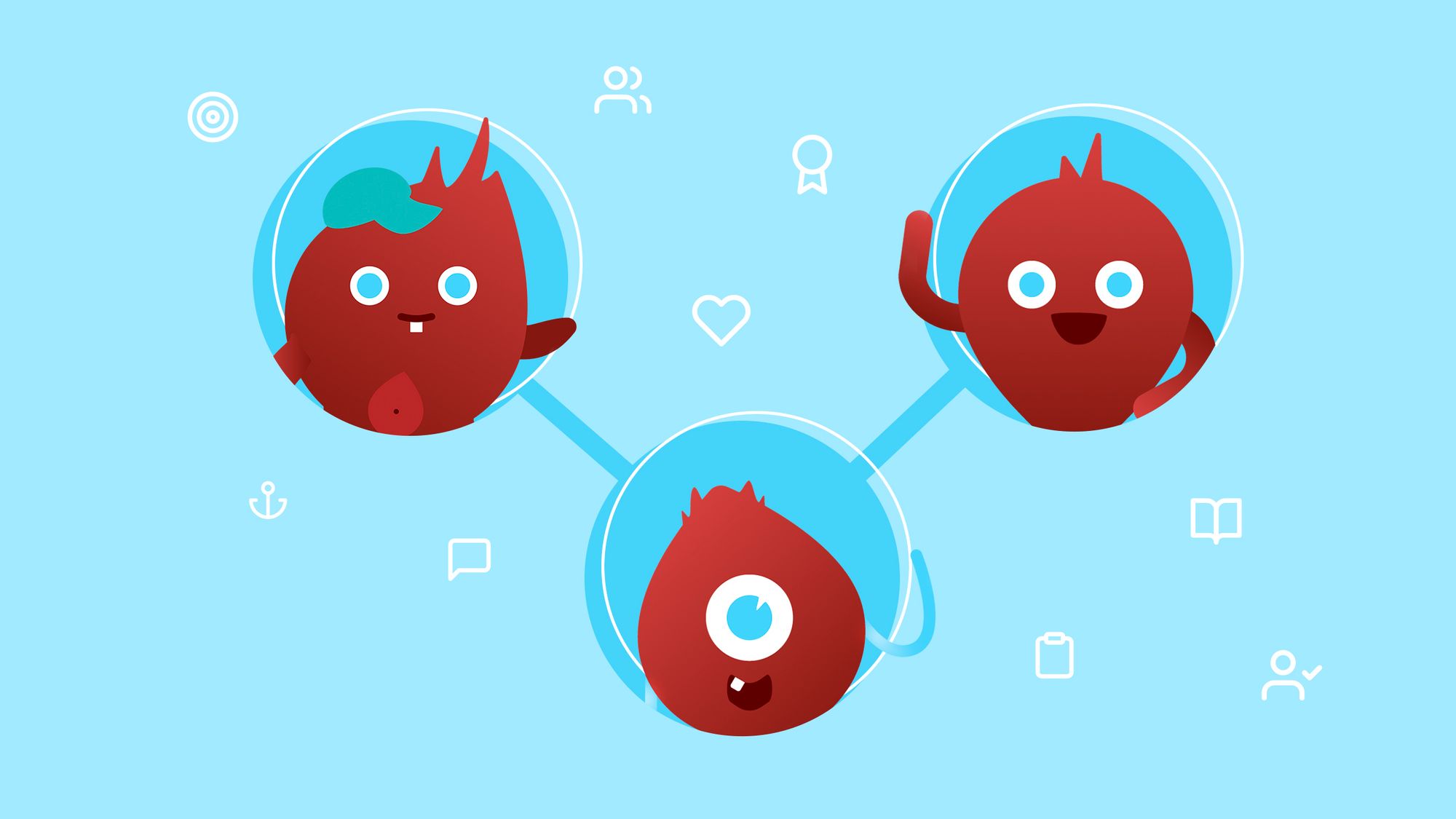2022-11-25 | Martin Grebner | 7 min read
Strengthening self-organization in the team - with Team Canvas
Self-organized teams benefit from clear advantages. But becoming truly self-organized is not as easy as it may seem. Our colleagues share their experiences on how self-organization at team level can be successful. Our tips bring more productivity as well as transparency and increase trust and cohesion within the team. For guidance, we also explain the Team Canvas method and provide specific questions ready to use.
Properly implemented, self-organization for teams provides orientation, ensures structures and strength-oriented responsibilities. But how can self-organization be created and promoted in a team? And in this context, what constitutes modern team leadership?
Self-organization and team leadership
Self-organized teams are a central element of agile working methods, including Scrum. In this context, self-organization means that the team has sufficient freedom within the organization to take responsibility for its own topics. Far-reaching, decision-making authority of the team is essential so that the team can structure its work independently. Team members are also responsible for regularly reflecting on their work in order to constantly improve working methods and organization.
Therefore, in self-organized teams, there is no leader in a traditional sense who distributes tasks to others. Rather, leadership without authority to issue directives as well as self-management is predominant. However, this type of team organization does not mean that everyone does everything or that all tasks are always completed together. Instead, a distribution of roles and tasks within the team results from other factors, like the different competencies of a diverse team.
This all sounds catchy, but it may also appear a bit easier than it actually is. The good news: With Team Canvas there is a helpful method for team development.
Why self-organization in the team at all?
The reasons for a change of a team composition are manifold. They can range from flexible forms of organization, changes caused by terminations and new hires to new product steps as well as additional product expansions. The effect often is the same: If a team changes, the goal is to regain performance quickly; which is characterized by productivity, efficiency and self-organization.
At the same time, with the increasing complexity of the modern working world, the longing for orientation is also steadily increasing: Not only operationally, for example to understand what current requirements or tasks exist (an approach that has proven useful in the world of Scrum and Design Thinking). But above all, to join forces, to make the common direction tangible, and to identify ways of participation.
Self-organization on a team level can be an answer to this.

Our method tip: Team Canvas
The Team Canvas is a moderated process that is jointly designed with the team and that aims at the agile values and principles, such as:
→ Transparency: with the help of the Team Canvas, essential components of the team such as mission, goals, roles, tasks, agreements, etc. become apparent to all team members (and beyond).
→ Communication: All team members are actively involved and thus create a common understanding.
→ Focus: By using the canvas/board, the team has "everything at a glance".
→ Commitment: The team decides on its own how the canvas is designed and filled with content. This strengthens self-commitment immensely.
Objectives of a Team Canvas
The Team Canvas can help to achieve the following objectives:
- Supporting the joint orientation of a team and with that strengthening cohesion within the team.
- Building the foundations for good teamwork.
- Starting/promoting exchange about the team's goals, roles, values, rules, and purpose.
- Creating a common understanding and orientation.
- Support regarding self-organization, motivation, and self-reflection.
- Onboarding of new team members.
- Eliminating possible misunderstandings/irritations within the team.
Structure and contents of the Team Canvas
The Team Canvas is available as a more simplified basic version with five areas as well as a more detailed version with the complete nine areas.
Team Canvas Basic (5 categories):

Purpose
This is about the "why". Why does the team exist? What is the purpose and benefit for the customer? What is the team's mission from a stakeholder perspective? For this category, it is important that the team agrees on one or two sentences. The essence of these sentences must be absolutely viable and have buy-in from all team members.
Guiding questions:
- Why do we do what we do in the first place?
- What are the motivations for working in our team?
- What is our vision of the team? Why do we exist?
Example: As a company, we want our solutions to contribute to a simple, sustainable, and fun world to live in.
Roles & Skills
This section is about identifying the team composition. Who are the team members and what roles do they take in the team. In the best case, roles are assigned through strength-based responsibilities that the team needs to accomplish its goals.
Guiding questions:
- What are your names?
- What are your key skills and strengths that you bring to the team?
- What role(s) do you have on the team?
- What are we called as a team?
Example: Name of the team: Crazy Coders
Goals
This one is straight-forward: The team agrees on common goals.
Guiding questions:
- What do we want to accomplish as a team?
- What is our most important goal that is feasible, measurable and time-bound?
Values
This category is about the core values / the key principles that you want to share within the team. The team should agree on the values so that everyone can accept the final list of values.
Guiding questions:
- What do we stand for?
- What shared values do we want to be central to the team?
- What are our drivers in the team?
- What are our guidelines/guiding principles in the team?
Example: We as a team hold the values of openness, transparency, courage close to our hearts.
Rules & Activities
In this area, the team agrees on common rules and activities. In particular, agreements on cooperation and self-organization can be made here.
Guiding questions:
- What rules do we want to implement after this session?
- How do we communicate with each other to keep us on the same page?
- How do we make decisions?
- How do we want to improve as a team?
- How do we deal with conflicts? Do we want to make agreements?
- What rules and rituals help us organize ourselves?
- How do we strengthen and empower ourselves as a team and take real responsibility?
Example: We "attack" the problem, not the person.
Team Canvas (all 9 categories)
Four additional areas are added to the complete version of Team Canvas: strengths and assets, weaknesses and risks, needs and expectations, and personal goals.

Strengths and Assets
The team is asked to name the most important skills (both hard skills and soft skills) and strengths of the team. Participants should be encouraged to share something about themselves and mention important qualities they see in their teammates.
Guiding Questions:
- What skills do we have in the team to accomplish our goals?
- What interpersonal/soft skills do we have?
- In which area are we really good at, either as individuals or as a team?
Weaknesses & Risks
For this category, the team is asked to identify the key weaknesses and areas for improvement that they see in themselves, as well as the obstacles they face as a team. The focus should be on reporting what the participants can find in themselves rather than discussing the weaknesses of others.
Guiding Questions:
- What weaknesses do we have as a team and as individuals?
- What "personal flaws" do I want the other team members to know about me?
- What obstacles and problems might we face?
Needs and Expectations
The team is asked to express the needs they have to be successful. This should be viewed as a continuation of the previous two sections: After expressing their strengths and weaknesses, team members should be able to articulate their needs to reinforce their strengths (and do their best despite their weaknesses).
Guiding Questions:
- What does each individual on the team need to be successful?
- How can we help each other on the team with our needs?
- How could the team help each member meet her/his needs?
Personal Goals
This category is all about the personal goals of the individual team members. Sharing these with the team should be voluntary, also personal goals don't have to be related to team goals necessarily.
Guiding Questions:
- Are there personal motivations or goals to share?
- To what extent do common and personal goals coincide?
- Where do team members see themselves in one, three or five years?
Preparation & Process - How to Team Canvas
Team Canvas is a strategic framework that helps to bring team members on the same page and align on a common vision. The tips below will help you to answer the guiding questions:
- Complete the Team Canvas in the form of a workshop.
- As a guideline, you should plan around 45 minutes for the basic Team Canvas and around two hours for the Team Canvas with all nine categories.
- A moderator can be very helpful to get the conversation going, to keep focus or steer the conversation.
- It is recommended to have an external moderator (meaning he/she is not part of the team) so that every team member – e.g. also the team's Scrum Master – can fully participate in the Team Canvas.
- Print out the Team Canvas in large format or prepare it on a digital whiteboard / Miro.
- The Team Canvas is completed collaboratively. Make sure all team members are present and sufficient time is available.
- Go through the boxes together one by one and answer the questions. Collect your stickies and discuss jointly afterwards.
- The Team Canvas is a living document that should be updated periodically - preferably once a year.
- A continuous review could be integrated into the retro. In case of major changes and shifts in the team or the environment, it is recommended to take more time and go through the workshop again.
Conclusion
Team Canvas is a helpful method for regularly reflecting on your teamwork. Furthermore, it helps to create a common picture and understanding and to make motivation visible – on the one hand through individual goals, but also through the common mission (purpose).
In addition to vision, purpose and goals, the Canvas creates a framework for independent and self-organized work with clear roles and actions – and thus for efficient and effective goal achievement. It also ensures effective and transparent self-organized collaboration within the team.
Scandiolife on Instagram.
Connect with us on LinkedIn.
Look what Scandio is tweeting.



